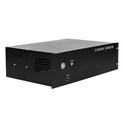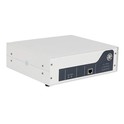Hey there! As a supplier of the ResoRing - 25 ultrasonic ring, I often get asked about its potential uses. One question that's popped up quite a bit lately is whether the ResoRing - 25 ultrasonic ring can be used for detecting paper. Let's dive into this topic and see what we can find out.
First off, let's talk a bit about what the ResoRing - 25 ultrasonic ring is. You can check out more details about it on this link: ResoRing - 25 Ultrasonic Ring. It's a nifty piece of equipment that uses ultrasonic technology. Ultrasonic waves are those high - frequency sound waves that are beyond the range of human hearing. These waves can be used in a variety of ways, like in cleaning applications where they create tiny bubbles that implode and clean surfaces. But can they be used for paper detection?
To understand if the ResoRing - 25 can detect paper, we need to know how paper interacts with ultrasonic waves. Paper is a porous material made up of fibers. When ultrasonic waves hit the paper, several things can happen. Some of the waves are absorbed by the paper, some are reflected back, and some pass through it. The amount of absorption, reflection, and transmission depends on factors like the thickness of the paper, its density, and the moisture content.
For example, thick and dense paper will absorb more ultrasonic waves compared to thin and light paper. Also, if the paper is wet, it will have different ultrasonic wave interaction characteristics than dry paper. Wet paper can absorb more waves because water is a good absorber of ultrasonic energy.
Now, let's think about how the ResoRing - 25 could be set up to detect paper. The ring emits ultrasonic waves and has sensors to detect the waves that come back. By analyzing the changes in the returning waves, we can potentially detect the presence of paper. If paper is in the path of the ultrasonic waves, the reflected waves will have different amplitudes, frequencies, and phases compared to when there's no paper.
One possible application could be in a paper - handling machine. In a printer or a copier, for instance, the ResoRing - 25 could be used to detect if there's a paper jam. If the ring detects that the ultrasonic wave pattern has changed in a way that indicates the presence of paper where it shouldn't be, it could send a signal to stop the machine and alert the user about the jam.
Another use could be in a paper - sorting system. Different types of paper have different ultrasonic signatures. By using the ResoRing - 25, we could sort papers based on their thickness, density, or other properties. For example, we could separate office paper from cardboard or recycled paper from virgin paper.
But there are also some challenges. One of the main issues is interference. In a real - world environment, there could be other objects or materials that also interact with ultrasonic waves and cause false detections. For example, dust particles in the air or other nearby equipment could reflect or absorb the waves and make it difficult to accurately detect the paper.
Also, the accuracy of paper detection depends on the calibration of the ResoRing - 25. We need to set the right parameters for the ring to be able to distinguish between paper and other objects. This might require some trial - and - error testing in different paper - handling scenarios.
Let's compare the ResoRing - 25 with another ultrasonic ring we offer, the ResoRing - 30 Ultrasonic Ring. The ResoRing - 30 has a different frequency range and power output compared to the ResoRing - 25. Depending on the specific paper - detection requirements, one ring might be more suitable than the other.
If we need to detect very thin and light paper, the ResoRing - 25 might be a better choice because it can operate at frequencies that are more sensitive to the subtle changes in the ultrasonic waves caused by thin paper. On the other hand, if we're dealing with thick and dense paper or need to detect paper over a larger distance, the ResoRing - 30 with its higher power output could be more effective.
In terms of the technical aspects, the ResoRing - 25 has a built - in microcontroller that processes the data from the sensors. This microcontroller can be programmed to perform different algorithms for paper detection. For example, we can use a pattern - recognition algorithm that compares the current ultrasonic wave pattern with pre - stored patterns of different types of paper.
We've also done some preliminary tests in our lab. We placed different types of paper in front of the ResoRing - 25 and analyzed the changes in the ultrasonic signals. The results were quite promising. We were able to detect the presence of paper in most cases, and we could even tell the difference between some types of paper based on the signal characteristics.
However, more extensive field testing is needed. We need to test the ResoRing - 25 in real - world industrial environments where there are more variables and challenges. For example, in a busy printing factory, there could be vibrations, noise, and other sources of interference that we haven't fully accounted for in the lab tests.
In conclusion, the ResoRing - 25 has the potential to be used for detecting paper. Its ability to emit and detect ultrasonic waves and analyze the returning signals makes it a candidate for paper - detection applications. But there are still some challenges to overcome, such as interference and calibration.


If you're interested in exploring the use of the ResoRing - 25 for paper detection in your business, I encourage you to get in touch. We can have a detailed discussion about your specific requirements and see how we can customize the ring to meet your needs. Whether it's for a small - scale paper - handling system or a large - scale industrial application, we're here to help.
References
- Ultrasonic Wave Interaction with Materials - A Basic Guide
- Research on Paper Properties and Their Effect on Ultrasonic Wave Propagation
- Industrial Applications of Ultrasonic Sensors in Material Detection





